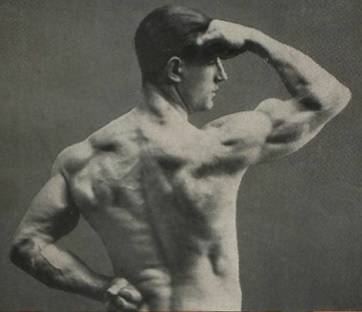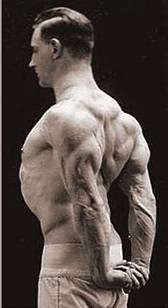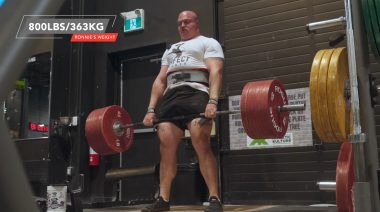Although many of the old-time strongman in the early 1900s were muscular, most paled in comparison to those who came later. But recently, I came across a strongman of the era who appears to be an exception.
Alan P. Mead’s physique was extraordinary and would be considered so even today. For starters, just notice his vascularity, which is absent in the photos of most other old-time strongman.
What allowed Mead to develop such a physique? Let’s take a look.
A Powerful Mind Over Matter
One reason for Mead’s success might be that in World War I he lost a leg below the kneecap. (Another strongman, Joe Nordquest, suffered the same fate.) Instead of feeling sorry for himself, Mead took up strength training and muscle control.
“An interesting record of strength that Mead performed was pulling over with straight arms a seventy-pound barbell for seventy repetitions.”
As you can see, none of these photographs feature his entire body. Being able to focus purely on his upper body may have been what allowed Mead to build this physique. As a result, he was sometimes called a “human anatomy chart.”

In his work The Philosophy, Science and Practice of MAXALDING, professor Juan Antonio Martinez Rojas stated:
The use of muscle control in order to relieve injuries and for rehabilitation is beyond any doubt. One of the most successful and famous fases was the training of Alan Mead by Monte Saldo. Alan Mead was badly injured during World War I and he lost a leg. In spite of this, wisely directed by Monte Saldo, he was able to develop one of the most amazing and perfect natural bodies of all times. The muscle control abilities of Alan Mead are also legendary. Many people think that he was probably one of the best after Maxick.
RELATED: Maxick Teaches Us the Lost Art of Muscle Control
Just how good was Mead at muscle control? Joe Assirati, cousin to famous strongman Bert Assirati, said:
Except of course for my father, my greatest inspiration was Alan P. Mead. In 1924, I witnessed a display of muscle control by him which remains vivid to this very day. The symmetry, proportion, and elasticity of his skin, and the tone of his muscles – his ability to control them – outshone anything I had seen before or have seen since…I was almost hypnotized by Alan’s muscle control.
“Alan P. Mead’s physique was extraordinary and would be considered so even today.”
Record-Breaking Strength
Alan Calvert wrote an article about Mead in an issue of Klein’s Bell, the short-lived magazine published by Siegmund Klein, describing a feat of muscle control that I’m not aware of it ever being equaled:
An English muscle enthusiast wrote me of seeing a posing exhibition by Alan Mead, during which that expert turned his back to the audience and made the muscles alongside the spine move so that they appeared to run up and down…This stunt of Mr. Mead is one of the few novel things in the line of muscle-control. When I first saw his pictured I noticed that he had the rare ability to display cross ridges in some of his muscles – just as though a long muscle was composed of circular cross sections strung together. He can even make his biceps take on a corrugated appearance when flexed; and in many of the photos of his back, the muscles alongside the spine appear as cables with parallel ridges…He must, for instance, flex the lower sections right above the hip bones (pelvis), relax that section, harden the section next above, and so on; thus giving the impression that the muscles are moving, altho he stands with his back flat and his spine straight. And, of course, after the top section has been contracted he can reverse the process, and make the flexed part of the muscles descend rapidly from the shoulder blades to the waist line.
RELATED: Siegmund Klein Shows Us a Different Way to Squat
Regarding Bert Assirati, who could hold a one-arm handstand at a bodyweight of 240lbs, Charles Smith reports an interesting story showing Mead’s generosity:
On his sixteenth birthday, Pops, as a special treat, took [Bert] to a physical culture exhibition. Two of the main acts were Alan P. Mead, famed muscle control artist, and another athlete, scheduled to make an attempt on a strand-pulling world’s record. This athlete, whose name I have forgotten, eventually broke the world’s record on the “front chest pull.” Throwing the expander down on the stage, he challenged any member of the audience to duplicate the feat of strength.
Bert, with a little prompting from Pop, jumped up on the stage, and performed 15 repetitions with the “world’s record.” The audience called loudly for Bert to strip off; just as our audiences do with the physique champions. Bert did and Alan P. Mead, standing to one side, was so amazed at the development of this youthful Samson that he took him to one side and asked him searching questions regarding his weight training. Five days later, a 225-lb. barbell and dumbell set arrived at Bert’s house, with a note attached from Mead containing a training schedule and his assurance that if he, Bert, trained along the right lines, he would become one of the strongest men in the world.

Mead Knew How to Succeed With Life Balance
Mead came from a distinguished and rich family of judges and lived most of his life in London where he was an attorney. He was devoted to his country, naming his daughters Mary and Elizabeth.
Unfortunately, not a whole lot was ever detailed about how he trained, though a couple things are clear:
- Mead was an innovator, creating several pulley apparatuses in order to train his body.
- The lat machine began its genesis from Mead’s work.
“Being able to focus purely on his upper body may have been what allowed Mead to build this physique.”
An interesting record of strength that Mead performed was pulling over with straight arms a seventy-pound barbell for seventy repetitions. He also would do flyes with the elbows locked out on a pair of rings. As is evidenced by these feats, he was noted for his chest, arm, and shoulder strength especially.
RELATED: Get Stronger Today With Lessons From Old-Time Strongmen
What lessons can you take from Mead’s experience that might apply to your own training? Do you ever incorporate mindfulness and muscle control into your routine? Share your thoughts in the comments below.
1. Gentle, David. “The Quest for Muscles.” The History of Physical Culture. Accessed December 29, 2014.
2. Thomas, A. “Joe Assirati: Reminiscences of Britain’s Renaissance of Strength.” Iron Game History. Accessed December 29, 2014.
3. Calvert, A. “Dancing the Spinal Muscles.” Legendary Strength. Accessed December 29, 2014.
4. Smith, C. “A Modern Hercules – Bert Assirati.” The Tight Tan Slacks of Dezso Ban. Accessed December 29, 2014.






